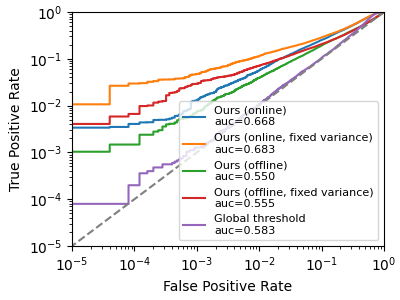| .. | ||
| scripts | ||
| dataset.py | ||
| fprtpr.png | ||
| inference.py | ||
| plot.py | ||
| README.md | ||
| score.py | ||
| train.py | ||
Membership Inference Attacks From First Principles
This directory contains code to reproduce our paper:
"Membership Inference Attacks From First Principles"
https://arxiv.org/abs/2112.03570
by Nicholas Carlini, Steve Chien, Milad Nasr, Shuang Song, Andreas Terzis, and Florian Tramèr.
INSTALLING
You will need to install fairly standard dependencies and python 3.11 minimum.
pip install scipy scikit-learn numpy matplotlib tensorflow tensorflow_datasets
# This needs to be separate
pip install objax
RELEASE_URL="https://storage.googleapis.com/jax-releases/jax_cuda_releases.html"
JAX_VERSION=`python3 -c 'import jax; print(jax.__version__)'`
pip uninstall -y jaxlib
pip install -f $RELEASE_URL jax[cuda]==$JAX_VERSION
RUNNING THE CODE
1. Train the models
The first step in our attack is to train shadow models. As a baseline that should give most of the gains in our attack, you should start by training 16 shadow models with the command
bash scripts/train_demo.sh
or if you have multiple GPUs on your machine and want to train these models in parallel, then modify and run
bash scripts/train_demo_multigpu.sh
This will train several CIFAR-10 wide ResNet models to ~91% accuracy each, and will output a bunch of files under the directory exp/cifar10 with structure:
exp/cifar10/
- experiment_N_of_16
-- hparams.json
-- keep.npy
-- ckpt/
--- 0000000100.npz
-- tb/
2. Perform inference
Once the models are trained, now it's necessary to perform inference and save the output features for each training example for each model in the dataset.
python3 inference.py --logdir=exp/cifar10/
This will add to the experiment directory a new set of files
exp/cifar10/
- experiment_N_of_16
-- logits/
--- 0000000100.npy
where this new file has shape (50000, 10) and stores the model's output features for each example.
3. Compute membership inference scores
Finally we take the output features and generate our logit-scaled membership inference scores for each example for each model.
python3 score.py exp/cifar10/
And this in turn generates a new directory
exp/cifar10/
- experiment_N_of_16
-- scores/
--- 0000000100.npy
with shape (50000,) storing just our scores.
PLOTTING THE RESULTS
Finally we can generate pretty pictures, and run the plotting code
python3 plot.py
which should give (something like) the following output
Attack Ours (online)
AUC 0.6676, Accuracy 0.6077, TPR@0.1%FPR of 0.0169
Attack Ours (online, fixed variance)
AUC 0.6856, Accuracy 0.6137, TPR@0.1%FPR of 0.0593
Attack Ours (offline)
AUC 0.5488, Accuracy 0.5500, TPR@0.1%FPR of 0.0130
Attack Ours (offline, fixed variance)
AUC 0.5549, Accuracy 0.5537, TPR@0.1%FPR of 0.0299
Attack Global threshold
AUC 0.5921, Accuracy 0.6044, TPR@0.1%FPR of 0.0009
where the global threshold attack is the baseline, and our online, online-with-fixed-variance, offline, and offline-with-fixed-variance attack variants are the four other curves. Note that because we only train a few models, the fixed variance variants perform best.
Citation
You can cite this paper with
@article{carlini2021membership,
title={Membership Inference Attacks From First Principles},
author={Carlini, Nicholas and Chien, Steve and Nasr, Milad and Song, Shuang and Terzis, Andreas and Tramer, Florian},
journal={arXiv preprint arXiv:2112.03570},
year={2021}
}
